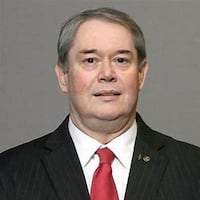“We want you here and we’re going to keep you here,” Wilson said during the meeting and added that Ohio Senate President Matt Huffman is willing to fly to meet with the new ownership.
Last month, state Rep. Adam Mathews, R-Lebanon, championed a funding request for $22.5 million.
In addition, the Warren County Commission has already pledged $10.5 million to retain the tournament.
City, business, regional and state officials have been working on the package for several months since September when the tournament was sold by the U.S. Tennis Association to billionaire businessman Ben Navarro of South Carolina for an undisclosed amount.
Last month, Navarro, who owns an investment company called Beemok Capital Group which is the new tournament owner, pitched a proposal to leaders in Charlotte, N.C. and Mecklenberg County to move it there. Navarro’s organization is seeking $400 million to build a new campus and move the tournament there starting in 2026, according to The Charlotte Observer.
The proposed new campus is envisioned to have 40 tennis courts including four stadiums, five additional match courts, a mix of hard, clay and indoor tennis and pickleball courts to be used year-round near the Catawba River. Beemok Capital is seeking to obtain one-third of the total development costs from public sources from both Charlotte and Mason, according to The Charlotte Observer.
Mason officials said they checked that box with Monday’s announcement. The tournament brings an economic development impact of $80 million a year and that is projected to increase to $207.2 million in 2025 when the tournament expands to two weeks.
Charlotte City Council is expected to vote on the $70 million on economic development incentives in the coming weeks.
At Monday’s meeting, Ford Perry, chief operations officer for Beemok Capital, was unable to attend due to testing positive for COVID-19. He spoke virtually to discuss what they envision for the Lindner Family Tennis Center in Mason, which began hosting the tournament in 1979. He said the “minimum needed” is $375 million to update and expand the Mason campus to become a year-round facility.
“We want to see the site used more as a sports tourism catalyst,” Perry said.
In his presentation, Perry identified $150 million in “critical improvements for 2025.” Those improvements include: Renovation of the Paul Flory Building; a new player building; Center Court facade improvements; South Tower and 1899 room renovation; 13 additional practice and match courts; new green space/park; parking lot renovation; new North, South, East, and West Entry Plazas; a new facilities building; food/beverage and fan plaza; restroom renovations; landscaping improvements; and utilities infrastructure enhancements.
Perry also identified $50 million improvements to utilize the facilities year-round that include eight indoor courts; a pickleball bar and restaurant; four outdoor and six indoor pickleball courts; and wi-fi and other technology enhancements.
The rest of the full scope master plan will cost an estimated $175 million that includes Center Court seat replacement; grandstand renovations; Stadium 3 renovations; permanent kitchens/commissaries; additional premium suites; new Paul Flory Building Hospitality Clubs; a new outdoor hospitality zone; campus-wide shading structures; an entry boulevard expansion; broadcast zone renovations; new merchandise building; wayfinding signage; and existing concrete repairs and structural improvements.
Perry said the Association of Tennis Players said there needs to be more emphasis on the Masters 1000 tournaments of which there are nine in the world, including the Western & Southern Open. The Masters 1000 is a pro tennis tournament just under the four Grand Slam tournaments.
Mason officials said they are working with local and regional partners, many of whom attended Monday’s meeting.
City Manager Eric Hansen said the tennis center hosts a multitude of volleyball and tennis tournaments, sand volleyball tournaments, graduations and college and high school tournaments.
“There’s still a lot of work to do and we’re still working on it,” he said. “It was a smart move by the state. You never want to reach the end.”
The 2025 expansion of the ATP/WTA tournament to two weeks plus year-round uses will represent a $300 million investment; 1,600 jobs; $207.2 million in regional economic impact; $54.6 million in earnings taxes; and 1,424 in anticipated construction jobs, according to city commissioned study completed last month from the University of Cincinnati Economics Center on the economic impact of the Western & Southern Open.
The Western and Southern Open is one of nine annual “Masters 1000″ tournaments on the Associated Tennis Professionals tour — a set of tournaments just a tier below the four annual Grand Slams, including the US Open. Hosting a Masters 1000 puts Mason in the company of cities like Shanghai, Rome, Madrid and Paris and brings an estimated 180,000 people to Warren County every year.
Western & Southern Open facts
- The Western & Southern Open is an annual outdoor hard court tennis event played annually. Founded in September 1899, the tournament was known for many years as the Cincinnati Open. It is the oldest pro tournament that is still played in the city of its origin.
- The annual tournament is played each August just prior to the U.S. Open.
- 19 of the top 20 men and women in tennis were at the Western & Southern Open in 2022.
- Nearly 200,000 fans attended the Western & Southern Open from all 50 states and 39 nations.
- Total TV and Streaming Audience was 62.7 million for the tournament.
- Since 1974, the tournament in Mason has raised more than $12 million for various charities in the Cincinnati region.
- The tournament provides an economic impact of about $80 million a year.
- More than 500 volunteers from the community help to put on the tournament.
SOURCES: Beemok Capital Group; Western & Southern Open.
About the Author
